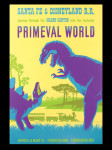When it comes to naming a carousel after a Disney movie, one can look back and easily arrive at Cinderella. It’s a natural fit, since she had a pet horse which was turned into a human, and mice which were also turned to horses for about twenty seconds of screen time. This obvious conclusion only requires you to overlook about ten other classic Disney movies that are more suited for carousel inspiration.
In spite of its carny ancestry, Cinderella’s Golden Carousel does have its charm. It’s the basis for one of those classic Disneyisms, the old chestnut about Walt wanting everyone to ride a white horse. There also used to be a classic chestnut about Walt not wanting any of those boring, non-moving benches like other carousels have, but that chestnut went away when the company added boring, non-moving benches a few years back.
Recently while touring Fantasyland, I noticed something else that had been added. It’s a practical detail, not a story one, and for all I know it has been that way for months (the Carousel is not always on my list of must-see rides). The outer rows of horses (i.e. the tallest ones) have had their old iron stirrups replaced by a 3-level staircase stirrup.
Obviously this is to solve a conundrum known as the Stationary Daddy Problem. Daddy, being a red-blooded American male, is too masculine to ride prancing white princess ponies. He elects to stand along the rail, where he will snap a picture of Junior as he rides by. By definition, this means that Junior must ride one of outer horses, but Junior is much too short to reach the stirrups. This leads to much screaming by Junior, frustration for Daddy, and a drinking problem for Mommy.
These new stirrups solve the problem by allowing children of various heights to ride the outer horses. It also provides new ways for obnoxious parkeologists to clown around, since this wikepedia article informs me that jockeys like high stirrups in order to better stride the horse.
Here is a side-by-side comparison of the inner horse (scientific term “equinidermis”) with the outer horse (“epequinidermis”).






